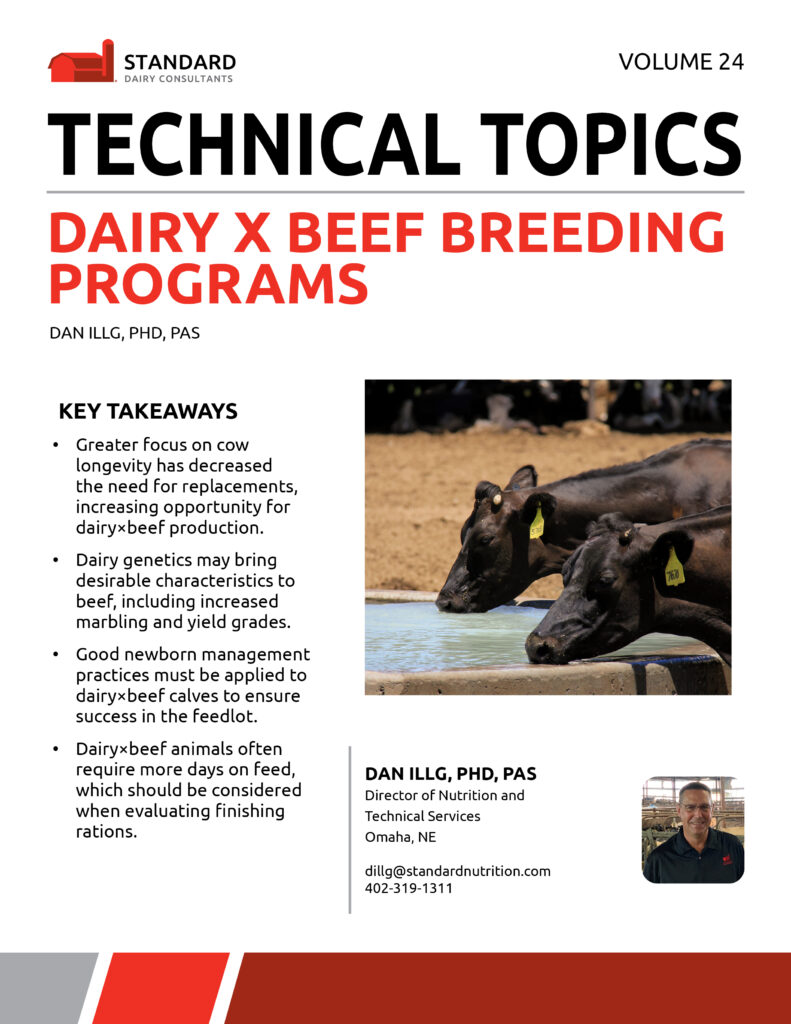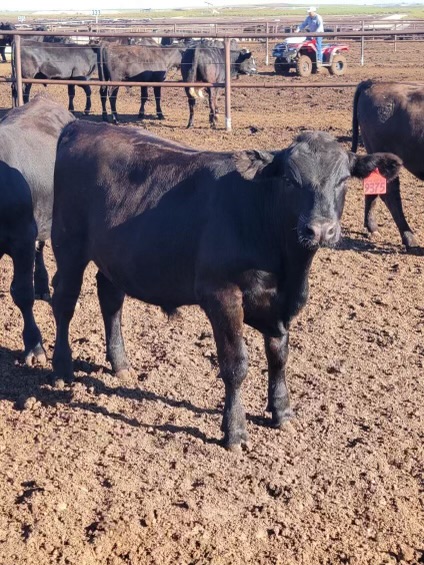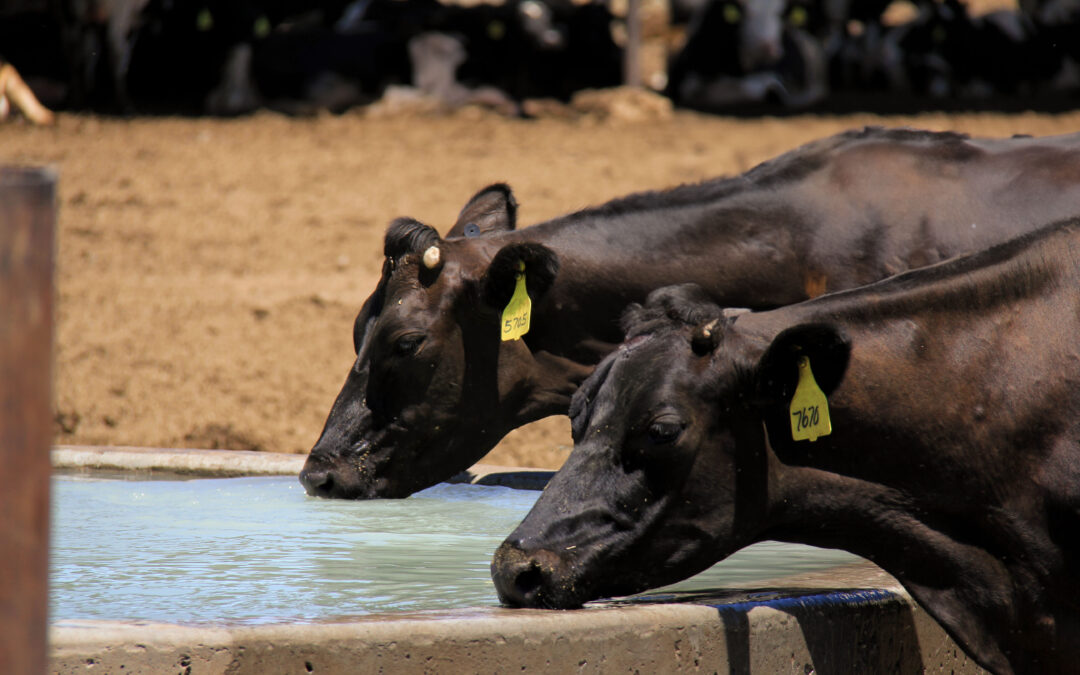Written by: Dan Illg, PHD, PAS
KEY TAKEAWAYS IN THIS ISSUE OF TECHNICAL TOPICS:
- Greater focus on cow longevity has decreased the need for replacements, increasing opportunity for dairy×beef production.
- Dairy genetics may bring desirable characteristics to beef, including increased marbling and yield grades.
- Good newborn management practices must be applied to dairy×beef calves to ensure success in the feedlot.
- Dairy×beef animals often require more days on feed, which should be considered when evaluating finishing rations.

The incorporation of beef semen into the breeding programs of dairy farms has advanced very rapidly in the past 5 years. What began as a means of getting more value out of calves born from older cows in the herd (terminal pregnancies) has become an important part of the dairy business.
CHANGING WITH THE TIMES
Dairy producers have changed a number of their goals in this time. The high cost of raising replacements has put a new emphasis on cow longevity. Extending the productive life of females on the dairy has become one of the primary objectives of the operations. Historically, producers could make and grow enough replacements for a dairy, and the breeding advancements justified the replacement of cows in the herd after 3 or 4 lactations. The cost of raising a replacement animal was much less than the value of the lactating cows.
That is not the case today. Raising replacements has become a substantial expense for the dairy. Keeping cows in the herd brings higher returns from a number of aspects, considering the cow has “paid for herself” approximately midway through 2nd lactation. The replacements that are no longer needed can be replaced by dairy×beef animals, which bring revenue to the dairy. As the herd ages, milk per cow generally increases. Less effort is needed to train new animals for the operation. One drawback of the aging herd is the tendency for an increase in health events such as metabolic issues like milk fever or physical injury.
A WINNING COMBINATION
Dairy genetics bring some important, positive considerations to the crossbred animal. There is a tremendous amount of consistency to the dairy breed, which will transfer to a more consistent animal in the feedlot than typically found in the beef breeds. Dairy genetics bring more muscle marbling, creating a meat with more tenderness and better flavor than the straight beef breed. The extensive record systems that dairy operations employ allow for much better traceability of the meat than a traditional cow/calf and feedlot combination. This is an advantage for programs that are looking for source and age verification for specialty and export markets.

Compared to dairy-only animals, dairy×beef animals are a more desirable size for the packing plant. The dairy×beef animals also yield better (62.8%) compared to dairy-only animals (60%). This is still a disadvantage compared to the beef breeds that can yield at 65%.
The characteristics of ribeyes for the dairy×beef are closer to the beef breeds in size, and the improved coloring allows grocers to market the beef and dairy×beef in the same display case. Meat from dairy-only animals generally requires a different position in the display case. From a packer and grocer perspective, this is a valuable aspect of the dairy×beef carcasses. Dairy×beef tends to have an improved rate of yield grades 1 and 2, resulting in reduced risk of yield grade discounts at the packer due to lower backfat. Additionally, without brands, hides are more valuable to the packing plant.
In the feedlot, the dairy×beef animals will grow similarly in average daily gain and feed: gain to that of conventional beef animals. The percentage that grades choice or higher is similar to conventional beef animals. The consistency of the supply of dairy×beef animals during the year helps to ensure a steady supply of meat and is not prone to the cyclicity of the traditional cow/calf system.
THE START DEFINES THE FINISH
An important consideration for dairy producers using the dairy×beef system in their herd is that caring for the crossbred calf is just as critical as replacing heifers. Whether thce ownership of the calf is retained by the farm or the calf is sold early, the start of life for this calf is vital for the success of its growth. Colostrum feeding, dipping navels and a clean environment for the calf are critical. Producers need to treat these calves as if they were retaining ownership. If calves are not started properly and do poorly in the feedlot, this will reflect poorly on the dairy and the dairy industry in general regarding the viability of dairy×beef crosses. This is a golden opportunity for the dairy industry that can be thwarted by producers who do not practice good management at the start. There is mounting data that suggest advantages for growth of these animals when they are fed milk replacer for at least eight weeks. Keeping these animals on milk longer will allow a more gradual adaptation to starter feed. The strong start of immune function from a good colostrum program, as well as growth and development from the milk and starter program will set these animals up for superior performance in the feedlot.
When processing these calves, such as with castration by banding, care must be taken to ensure that both testicles are captured by band. When banding at a very young age, one testicle can still be in the body cavity of the calf and will influence the growth and reduce the value of the meat at slaughter.
A recent survey indicated that dairy×beef animals are more prone to lung issues (80%) than conventional beef calves. This is why a great colostrum and growth program is very critical. It is also the reason that calves that display respiratory illness need to be kept out of the feedlot groupings. Again, perception will become the dairy×beef industry’s reality.
CHOOSE WISELY – SUCCESS DEPENDS ON IT
The decision to move to a dairy×beef program is just the start. Sire selection is as important in a dairy×beef program as it is in the dairy replacement breeding. What breed to choose, Angus or Continental, will be determined by dairy breed and cows on the farm. The decision on what breed is influenced by the objectives of the dairy×beef growth program. Continental breeds tend to produce larger ribeye than Angus, but Angus bulls contribute to more marbling in the meat.
The primary point to be made is that the bulls chosen must be above breed average for the most characteristics.

The choice of breed, and then which bulls within breed, must be strategic breeding to low cost, low end of the breed will not result in the animal that benefits the dairy producer, grower, or packer. Conception rate of the bull is also very important. Putting semen in the animal is the easy part. Getting a calf on minimal breed activity will help this enterprise in the dairy.
Calving ease has been a concern in the past for beef breedings to dairy animals. Genetics companies have been emphasizing calving ease, and good sires can be found with this desired characteristic. The gorilla in the corner of the room for the dairy×beef feeding programs is prevalence of liver abscesses in these animals at the packing plant. Feeding programs must be centered on this issue to avoid the discounts that diminish the profit potential for the dairy, the feeder, and the packer. Animals with dairy genetics typically take longer to “feed out” and therefore require a less energy-dense diet, with a diet with lower levels of fermentable carbohydrates than conventional finishing rations. Prolonged exposure to low rumen pH introduces the potential for severe acidosis leading to liver abscess – the feedlot nutritionist should tailor finishing rations to dairy×beef that are less aggressive than traditional feedlot diets.
WRAPPING THINGS TOGETHER
In summary, a contracting beef cattle herd has presented a lucrative opportunity to the dairy producer by way of supplying feedlots and packers with dairy×beef animals. The fundamentals of sound calf rearing should not be overlooked so that the dairy industry may continue to benefit – a welcomed “cash cow” to offset recent years’ low milk prices and high input costs.


